Every January, despite the typically cold weather, certain hardy plants showcase their resilience by blooming during this winter month. In this article, we’ll explore ten types of flowers that flourish in January, each with its unique characteristics and charm.
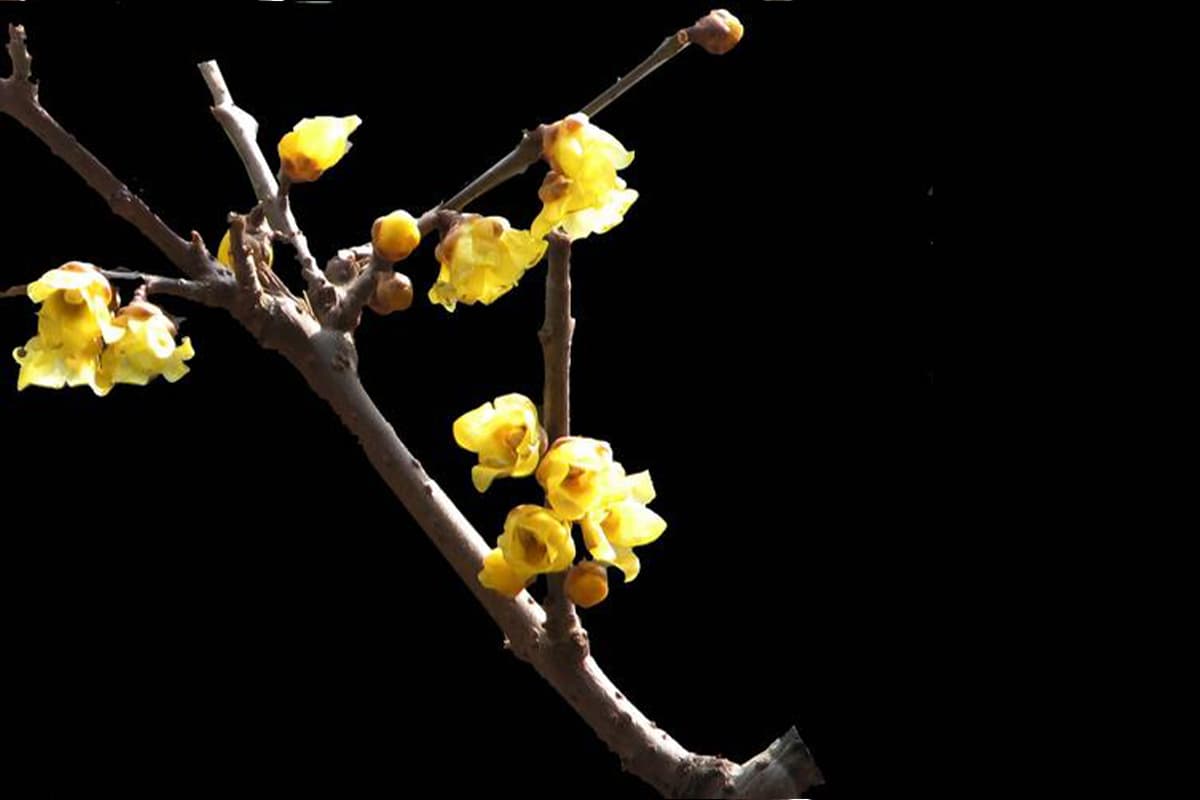
Wintersweet (Chimonanthus praecox), also known as Japanese allspice, is a deciduous shrub that flowers precisely when winter is at its coldest, typically in January. During this harsh period, it blossoms amidst frost and snow, embodying the Chinese spirit of resilience and perseverance in the face of adversity.
This remarkable plant provides a unique sensory experience, offering both visual beauty and a delightful fragrance that can perfume an entire garden. Wintersweet blooms from mid-November until March of the following year, boasting an impressive viewing period of over 100 days. Its exceptional cold hardiness, coupled with its cultural significance, has earned it a place among China’s most renowned flowers.
The flowers of Wintersweet typically have six to eight waxy petals arranged in multiple layers, rather than five as previously stated. These blossoms are usually pale yellow with a purple-brown center, though some cultivars may have different color variations. The flowers’ structure and appearance have led to their association with various symbolic meanings in Chinese culture, including nobility, strength, and humility.
Wintersweet has been a popular subject in Chinese poetry and art for centuries, often praised for its ability to bloom in adverse conditions. This quality has made it a metaphor for resilience and inner beauty in literature and philosophy.
From a horticultural perspective, Wintersweet is incredibly versatile. It’s well-suited for:
Additionally, Wintersweet has practical uses beyond ornamental purposes. Its flowers can be used to flavor tea, and some parts of the plant have traditional medicinal applications in Chinese herbal medicine.
For optimal growth, Wintersweet prefers well-drained soil and a position in full sun to partial shade. It’s relatively low-maintenance, requiring only occasional pruning to maintain its shape and promote healthy growth.
In conclusion, Wintersweet stands out as an ideal flower for winter appreciation, offering beauty, fragrance, and symbolic meaning during the coldest months of the year. Its resilience and charm continue to captivate gardeners and nature enthusiasts alike, making it a treasured addition to winter landscapes.
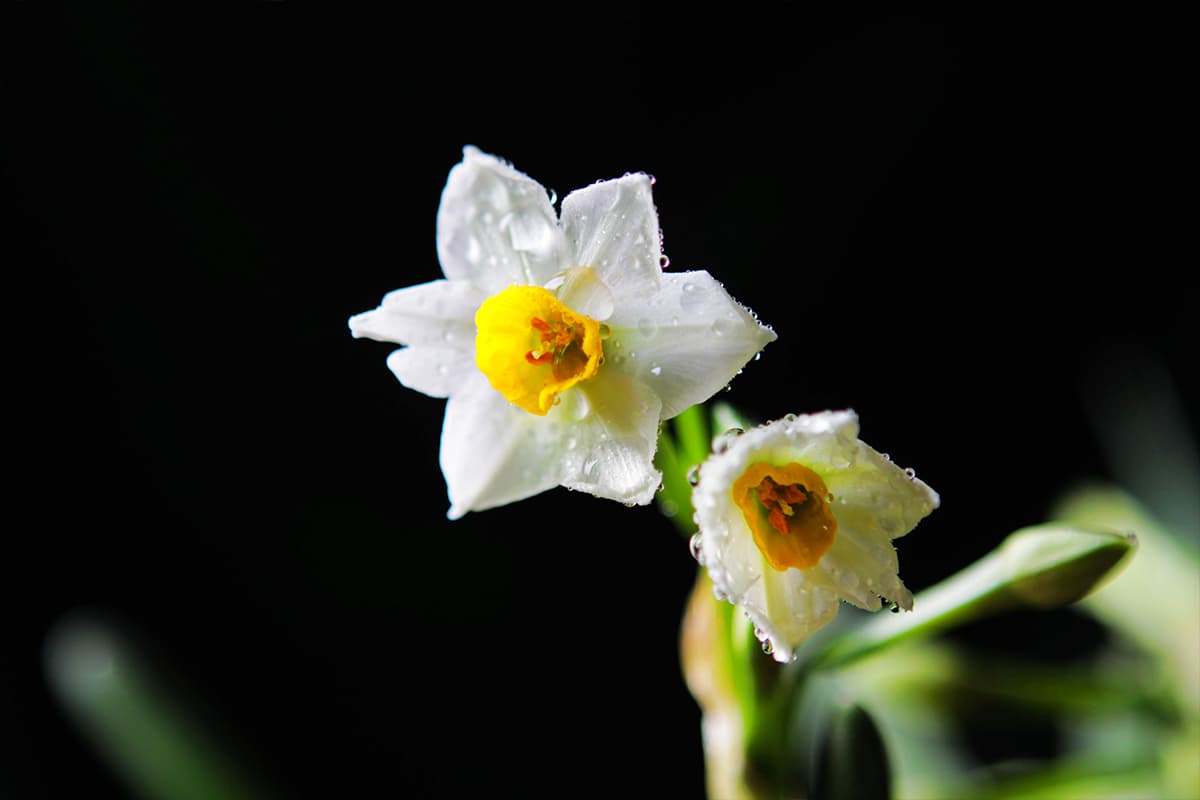
The Narcissus, commonly known as the Daffodil, is a prominent flower that blooms in winter, typically from January to February. Renowned as one of China’s top ten famous flowers, the Narcissus boasts a cultivation history spanning over two millennia, not just a thousand years.
Narcissus tazetta, the variety most commonly cultivated in China, is prized for its natural beauty, delicate fragrance, pure elegance, and transcendent charm. These qualities have earned it a place among the traditional “Four Gentlemen” of Chinese flora, alongside orchids, chrysanthemums, and bamboo (not iris). This classification reflects its cultural significance in Chinese art and literature.
Furthermore, the Narcissus is indeed considered one of the “Four Friends of Winter” or “Four Gentlemen of Winter,” along with plum blossoms, camellias, and wintersweets (Chimonanthus praecox). These plants are celebrated for their ability to thrive and bloom during the cold winter months, symbolizing resilience and hope.
The Narcissus is particularly admired for its ease of cultivation. It can be grown hydroponically with just a shallow dish of water and a few pebbles, making it an ideal indoor plant during winter. When placed on a windowsill, it not only radiates charm but also fills the room with its subtle, sweet fragrance, evoking a sense of spring’s imminent arrival even in the depths of winter.
In Chinese culture, the Narcissus holds special significance during the Lunar New Year celebrations. Its blooming period coincides with this important festival, making it a popular choice for festive decorations and gifts. The flower symbolizes good fortune, prosperity, and new beginnings, aligning perfectly with the spirit of the New Year.
Historically, the Narcissus was indeed part of the annual tribute system in imperial China. Its inclusion in this system underscores its high status and the value placed on it by the imperial court, further cementing its cultural importance.
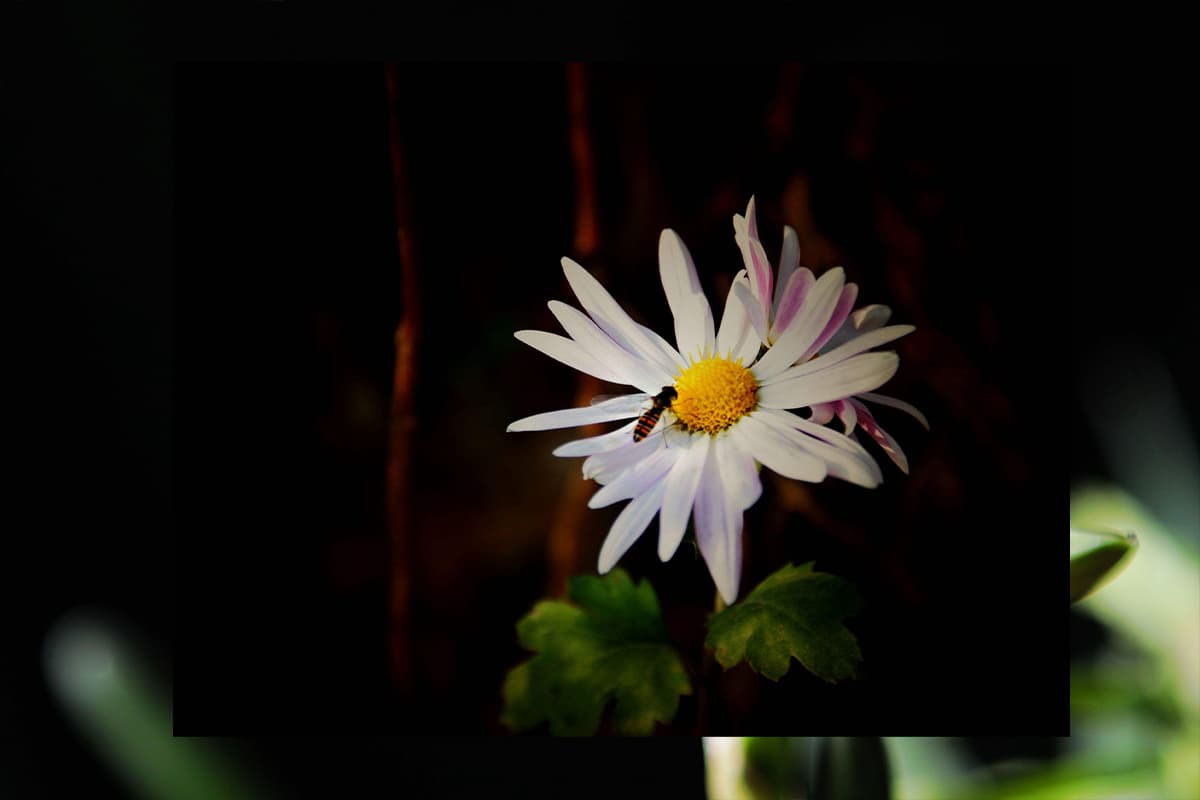
Winter Chrysanthemums (Chrysanthemum x morifolium), unlike their autumn-blooming counterparts, are a remarkable variety that flourishes in the colder months. These hardy perennials have developed a superior cold tolerance, typically initiating their bloom cycle in December and continuing through February, providing a vibrant display when many other plants are dormant.
As a testament to their resilience, Winter Chrysanthemums can often be seen blooming even amidst snowfall, creating a striking contrast against the white landscape. This ability is due to their enhanced frost resistance and efficient nutrient storage mechanisms that allow them to thrive in lower temperatures.
When cultivating Winter Chrysanthemums, providing adequate sunlight is crucial, particularly during their peak blooming period. These plants thrive with exposure to more than eight hours of direct sunlight daily, which ensures robust flowering and helps maintain their compact growth habit. In regions with shorter winter days, supplemental lighting may be beneficial to achieve optimal blooming.
Proper watering practices are essential for Winter Chrysanthemums, especially during the colder months. It’s important to strike a balance, avoiding overwatering while maintaining slightly damp soil. Allow the top inch of soil to dry between waterings, as excessive moisture can lead to root rot, a particular concern in cooler temperatures when evaporation rates are lower.
To promote healthy growth and abundant blooms, consider these additional care tips:
By following these guidelines, gardeners can enjoy the unique beauty of Winter Chrysanthemums, adding color and interest to their winter landscapes when most other flowering plants are in repose.
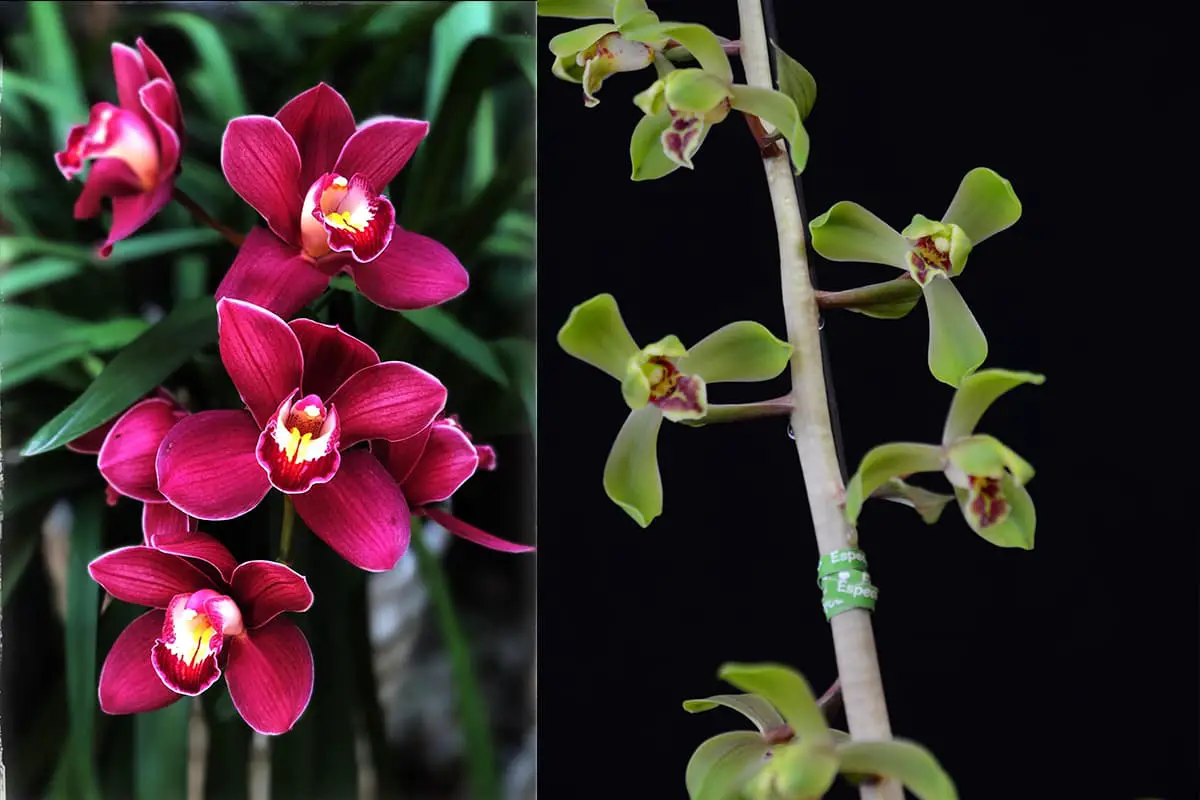
The Cymbidium Orchid, a renowned winter-flowering genus, is prized for its elegant blooms that grace the colder months from October to February. This orchid, native to tropical and subtropical Asia and northern Australia, is known by several names, including Boat Orchid and, in Chinese culture, as 蟹爪兰 (Xiè zhuǎ lán) or Crab Claw Orchid due to the shape of its pseudobulbs.
Cymbidiums are characterized by their striking, long-lasting flowers which come in a diverse array of colors including white, green, yellowish-green, cream, yellow, brown, pink, and red. The flowers are borne on tall spikes (inflorescences) that can reach up to 90 cm in length, each carrying multiple blooms. Their sword-shaped leaves add to their ornamental value even when not in flower.
While Cymbidiums are often cultivated as potted plants for indoor enjoyment, they are not typically grafted onto other plants. Instead, they are grown from division of mature plants or from seed. Their robust growth is achieved through proper cultural practices rather than grafting.
Despite their winter-blooming nature, Cymbidium orchids are not cold-hardy plants. They thrive in moderate temperatures, preferring daytime temperatures between 18-29°C (65-85°F) and nighttime temperatures between 10-18°C (50-65°F). During winter, it’s crucial to protect them from frost by moving them indoors or to a sheltered location when temperatures approach freezing.
Cymbidiums prefer bright, indirect light. In fact, light management is key to inducing blooming. They require a period of cooler nights (around 10-13°C or 50-55°F) and shorter days in late summer and fall to initiate flower spike development. Once flower spikes appear, maintain consistent temperatures to support bloom development.
These orchids thrive in environments with good air circulation and moderate humidity (50-70%). They should be planted in a well-draining orchid mix and watered thoroughly when the growing medium begins to dry out. Fertilize regularly during the growing season with a balanced orchid fertilizer, reducing feeding as winter approaches.
To extend the blooming period, which can last up to eight weeks, keep the plants away from heat sources and direct sunlight. Proper care and environmental control can result in spectacular floral displays, making Cymbidium orchids a cherished addition to any indoor garden or conservatory during the winter months.
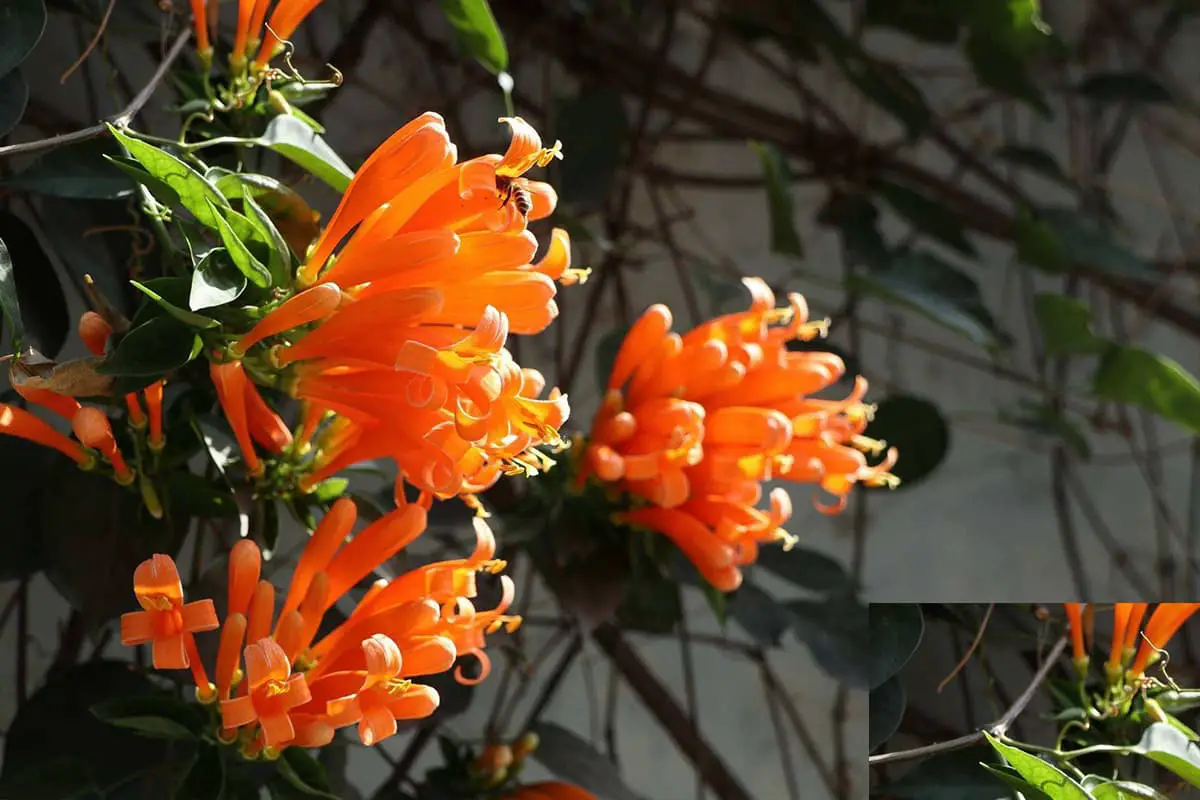
Pyrostegia venusta, commonly known as flame vine or orange trumpet vine, is a spectacular climbing plant native to Brazil, Paraguay, and northern Argentina. This vigorous evergreen has gained popularity worldwide for its stunning floral displays and adaptability to various climates.
The flame vine thrives in full sun to partial shade and prefers well-draining, fertile soil with a slightly acidic to neutral pH (6.1-7.5). While it appreciates consistent moisture, established plants demonstrate moderate drought tolerance. In tropical and subtropical regions, Pyrostegia venusta grows as a perennial, while in cooler areas it’s often cultivated as an annual or container plant.
This fast-growing climber can reach impressive heights of 40-50 feet (12-15 meters) with proper support. Its robust growth habit makes it ideal for covering fences, arbors, pergolas, and large trellises. In tropical Asia, particularly in countries like India, Singapore, and Malaysia, it’s a popular choice for adorning garden structures and creating colorful privacy screens.
The flame vine’s most striking feature is its profuse clusters of tubular, bright orange flowers that measure 2-3 inches (5-7.5 cm) in length. These vivid blossoms appear in terminal and axillary racemes, creating a spectacular fiery display that justifies both its common name and its scientific epithet “venusta,” meaning charming or elegant in Latin. The flowers are not only visually appealing but also attract hummingbirds and butterflies, enhancing garden biodiversity.
Pyrostegia venusta’s blooming period typically spans from late autumn through early spring (January to June in the Northern Hemisphere), providing vibrant color during months when many other plants are dormant. In frost-free climates, it may bloom for extended periods or even year-round.
To maintain its health and appearance, regular pruning after flowering is recommended to control its vigorous growth and encourage bushiness. This also provides an opportunity to shape the vine and prevent it from becoming invasive in favorable conditions. While generally pest-resistant, the flame vine may occasionally face issues with scale insects or mealybugs, which can be managed with horticultural oils or insecticidal soaps.
Due to its rapid growth and spreading nature, Pyrostegia venusta should be planted with caution in areas where it might outcompete native species. In some tropical regions, it has naturalized and is considered potentially invasive. Therefore, responsible cultivation and management are crucial to enjoy its beauty without environmental detriment.
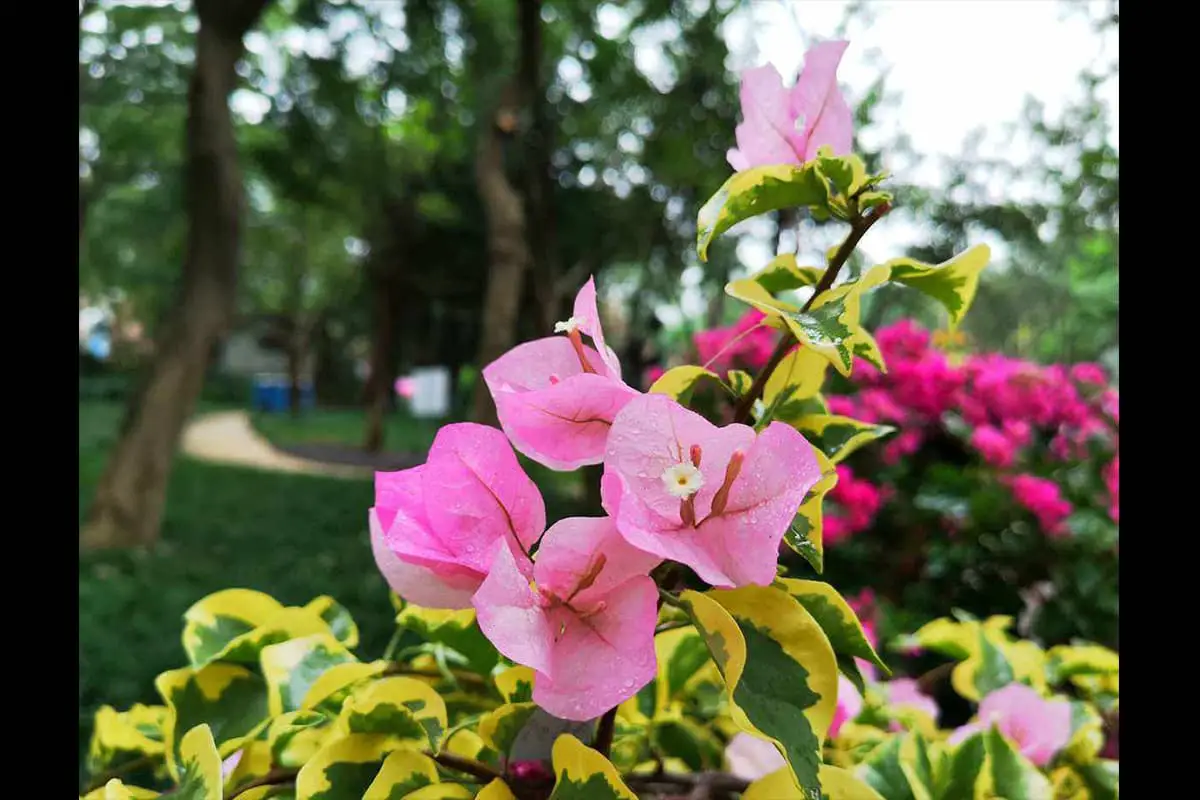
Bougainvillea, commonly known as paper flower, is a vibrant and versatile genus of flowering plants that typically blooms from November to June, though the exact period can vary depending on climate and cultivar.
Native to South America, particularly Brazil, Bougainvillea thrives in warm, sunny environments with well-draining soil. Its remarkable adaptability allows it to flourish in various climates, from tropical to Mediterranean. While widespread in southern regions, it can also be successfully cultivated in colder northern areas, often as a greenhouse or conservatory plant where it can be protected from frost.
The true flowers of Bougainvillea are small, tubular, and usually white or yellowish. However, what catches the eye are the large, colorful bracts surrounding these flowers. These papery bracts come in a spectacular array of colors, including vivid reds, oranges, pinks, purples, and whites. Some cultivars even feature multi-colored or variegated bracts.
Interestingly, these bracts are often mistaken for petals due to their leaf-like appearance and vibrant coloration. This characteristic has earned Bougainvillea the alternative name “leaf flower” in some regions. The bracts serve to attract pollinators to the inconspicuous true flowers they surround.
Bougainvillea is a woody vine or shrub that can be trained to grow as a climbing plant, ground cover, or even shaped into a tree form. Its thorny stems and drought tolerance make it an excellent choice for security hedges in warmer climates. With proper care, including regular pruning and adequate sunlight, Bougainvillea can provide a stunning, long-lasting floral display in gardens, on walls, or in containers.
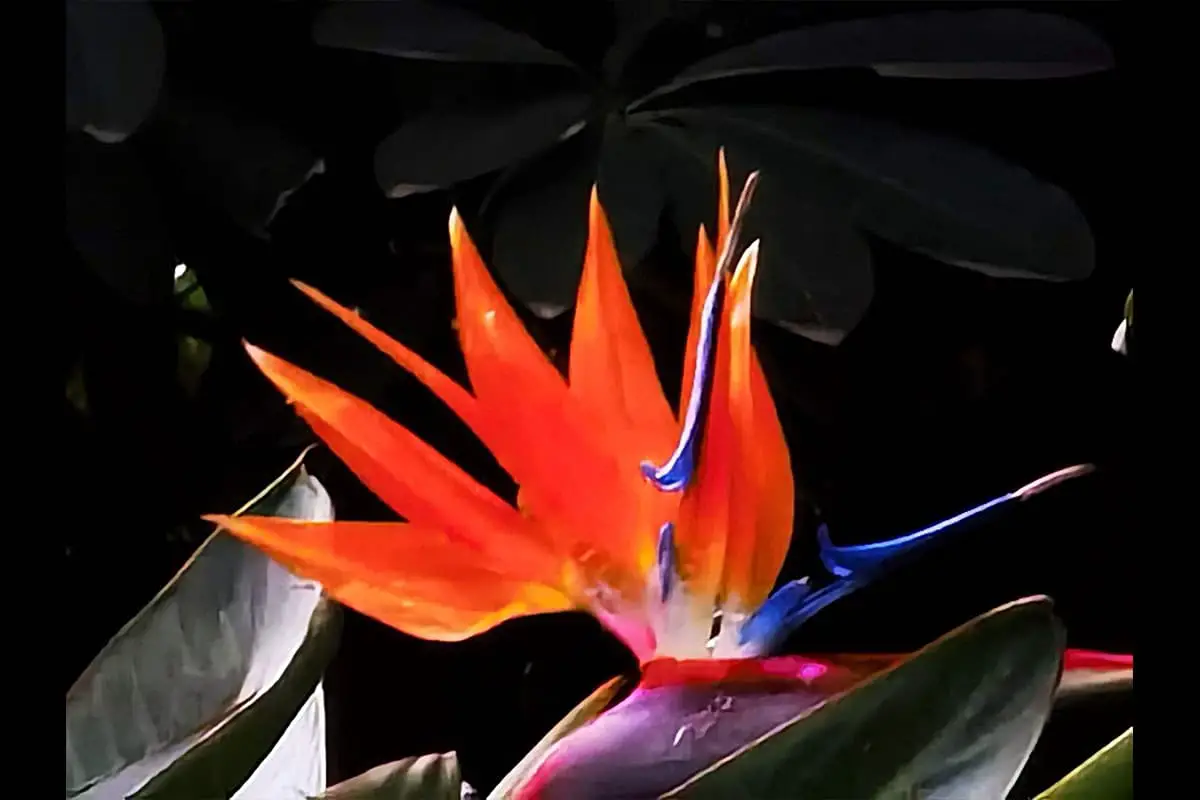
Strelitzia reginae, commonly known as the bird of paradise or crane flower, is a striking tropical plant native to South Africa. It typically blooms from late winter through spring, with some flowers persisting into early summer in ideal conditions. This spectacular species is widely cultivated in parks and gardens of subtropical regions, including southern China. In cooler northern areas, it is often grown in greenhouses or as a prized indoor plant.
The bird of paradise boasts impressive foliage consisting of long, leathery, oval-shaped leaves that grow in a fan-like arrangement. These leaves can reach up to 30-60 cm in length and 15-20 cm in width, creating a lush, tropical appearance even when the plant is not in bloom.
The flowers of Strelitzia reginae are truly remarkable, resembling the head of an exotic bird in flight. They emerge from a horizontal, boat-shaped bract called a spathe, which is typically 15-20 cm long and colored a rich green with striking purple edges. From this spathe, the vibrant flowers emerge sequentially:
Each individual flower can last approximately 5-7 days, with new blooms continuously emerging from the spathe. A healthy plant can produce multiple spathes, extending the overall flowering period to around 2-3 months under optimal conditions.
The bird of paradise thrives in bright, indirect light and prefers well-draining soil. It is relatively drought-tolerant once established but benefits from regular watering during its active growing season. In colder climates, it can be grown as a striking indoor plant, adding a touch of tropical elegance to interior spaces.
Strelitzia reginae not only serves as an ornamental plant but also holds cultural significance. In its native South Africa, it is known as “crane flower” and is featured on the country’s 50-cent coin. The plant’s unique beauty and symbolism of freedom and paradise have made it a popular choice for floral arrangements and as an emblem in various contexts worldwide.
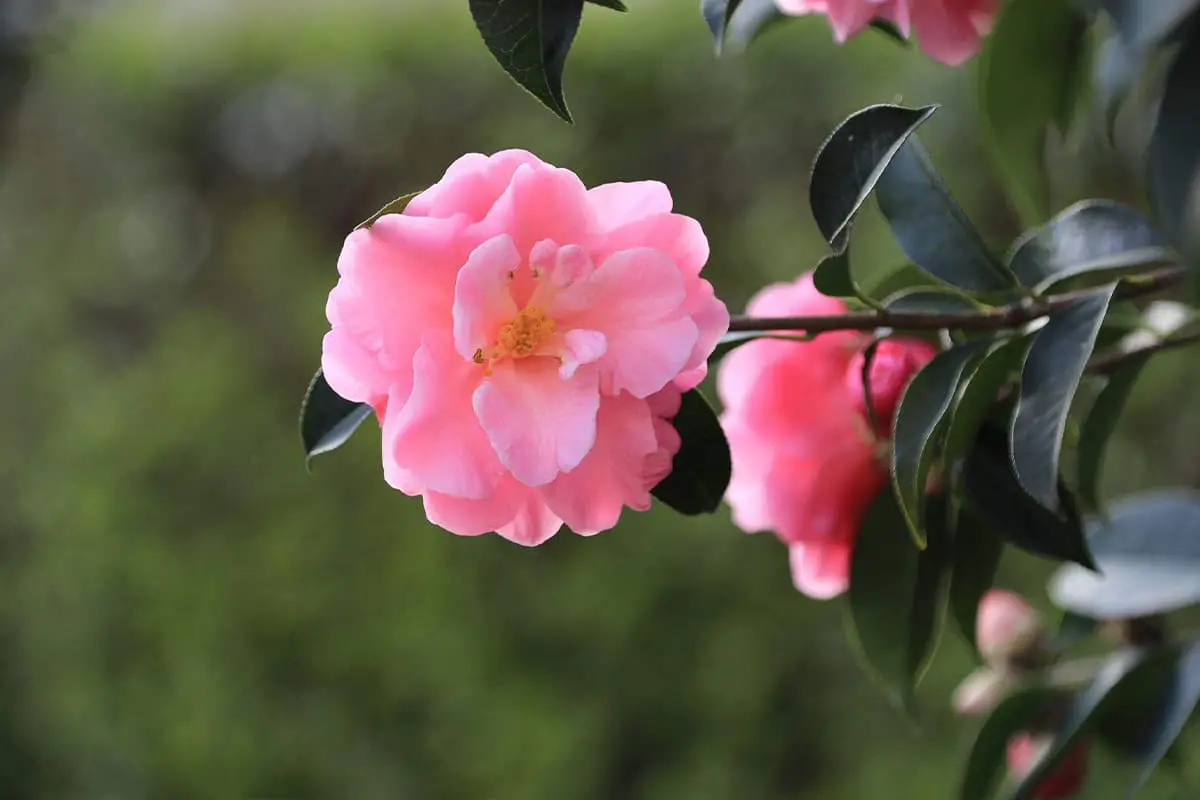
Camellias (Camellia spp.) boast an impressively long blooming period, spanning from late autumn to early spring. While individual flowers typically last for several weeks, the entire blooming season extends from October to May of the following year, with peak flowering generally occurring between January and March.
These evergreen shrubs or small trees have been cultivated in China for over a thousand years and are revered as one of the “Top Ten Famous Flowers” in Chinese culture. Their significance extends beyond China, as they are recognized globally for their ornamental value and are considered among the world’s most precious flora.
Camellia flowers exhibit a diverse range of colors, including various shades of red, pink, purple, white, and yellow. Some cultivars even produce striking bicolor or multicolored blooms with intricate patterns of stripes or mottling. The flowers can be single, semi-double, or fully double, with sizes ranging from 5 to 12 cm in diameter.
The Camellia plant itself is a robust, slow-growing woody shrub or small tree that can reach heights of 2 to 20 meters, depending on the species and growing conditions. The most commonly cultivated ornamental species, Camellia japonica, typically grows to 4-5 meters in height.
Native to Eastern and Southern Asia, camellias thrive in regions with mild, humid climates. In China, they are extensively cultivated throughout the Yangtze River Basin, Pearl River Basin, and in provinces such as Chongqing, Yunnan, and Sichuan. Their cultivation has also spread to other East Asian countries including Korea, Japan, and Taiwan, as well as parts of India.
Camellias prefer slightly acidic, well-draining soil and partial shade, making them ideal for woodland gardens or as understory plants. Their glossy, dark green leaves provide year-round interest, while their winter-blooming habit makes them particularly valuable in temperate gardens where few other plants flower during the colder months.
In addition to their ornamental value, some camellia species have significant economic importance. Camellia sinensis, for instance, is the source of tea leaves used to produce various types of tea, while Camellia oleifera is cultivated for its seed oil used in cooking and cosmetics.
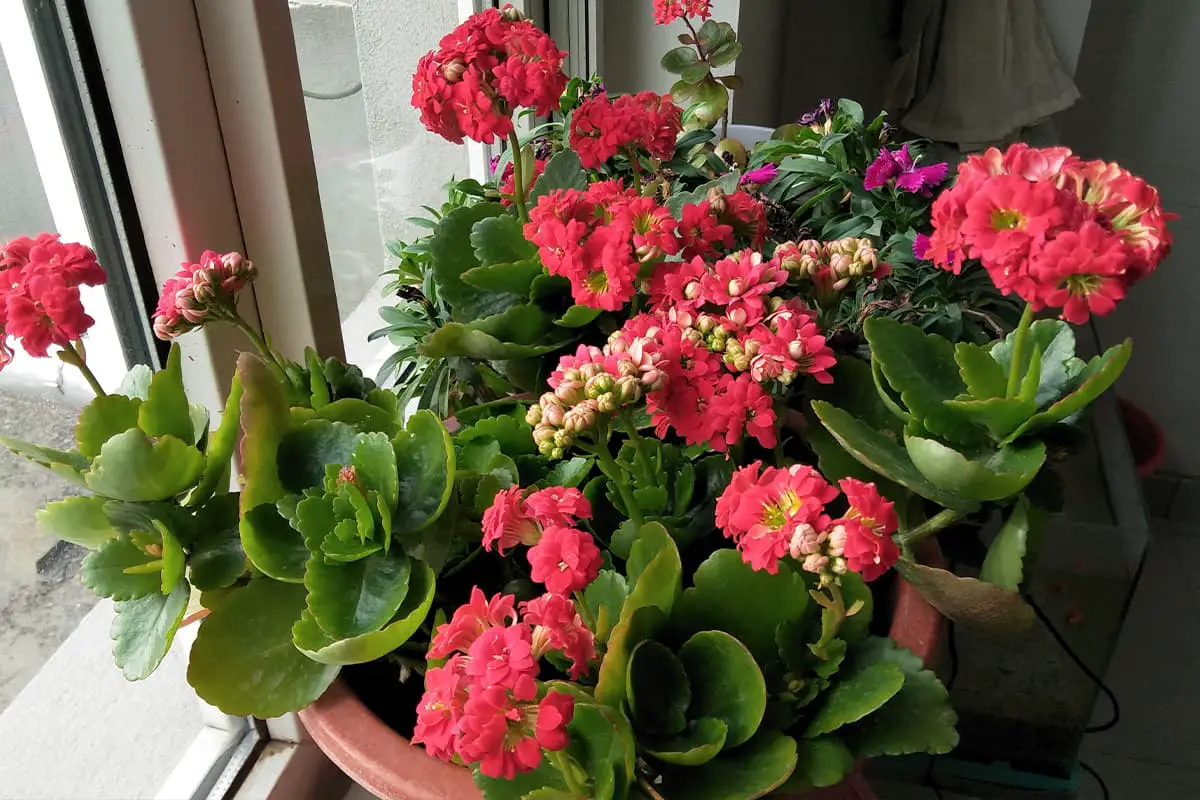
Kalanchoe blossfeldiana, commonly known as flaming Katy, Christmas kalanchoe, or florist kalanchoe, is a popular succulent perennial that belongs to the Crassulaceae family. Its vibrant blooming period typically spans from December to April, making it a cherished winter-to-spring flowering plant.
This compact, bushy succulent boasts a rich variety of flower colors, including shades of red, pink, orange, yellow, and white. The small, four-petaled flowers cluster together in dense, umbrella-like inflorescences, creating stunning floral displays atop thick, dark green leaves.
Highly valued for its ornamental qualities, flaming Katy is prized for its long-lasting blooms and relatively low maintenance requirements. In many cultures, it’s associated with longevity, abundance, and good fortune, making it a popular gift plant and a favorite among gardening enthusiasts.
Native to Madagascar, K. blossfeldiana has adapted well to indoor environments, thriving in bright, indirect light. Its drought-tolerant nature, stemming from its succulent characteristics, allows it to withstand occasional neglect, making it an excellent choice for both experienced gardeners and beginners alike.
To encourage repeat blooming, provide Kalanchoe with a period of long nights (12-14 hours of darkness) for about six weeks, mimicking its natural short-day flowering response. This photoperiodic treatment, combined with proper care, can result in magnificent floral displays year after year.
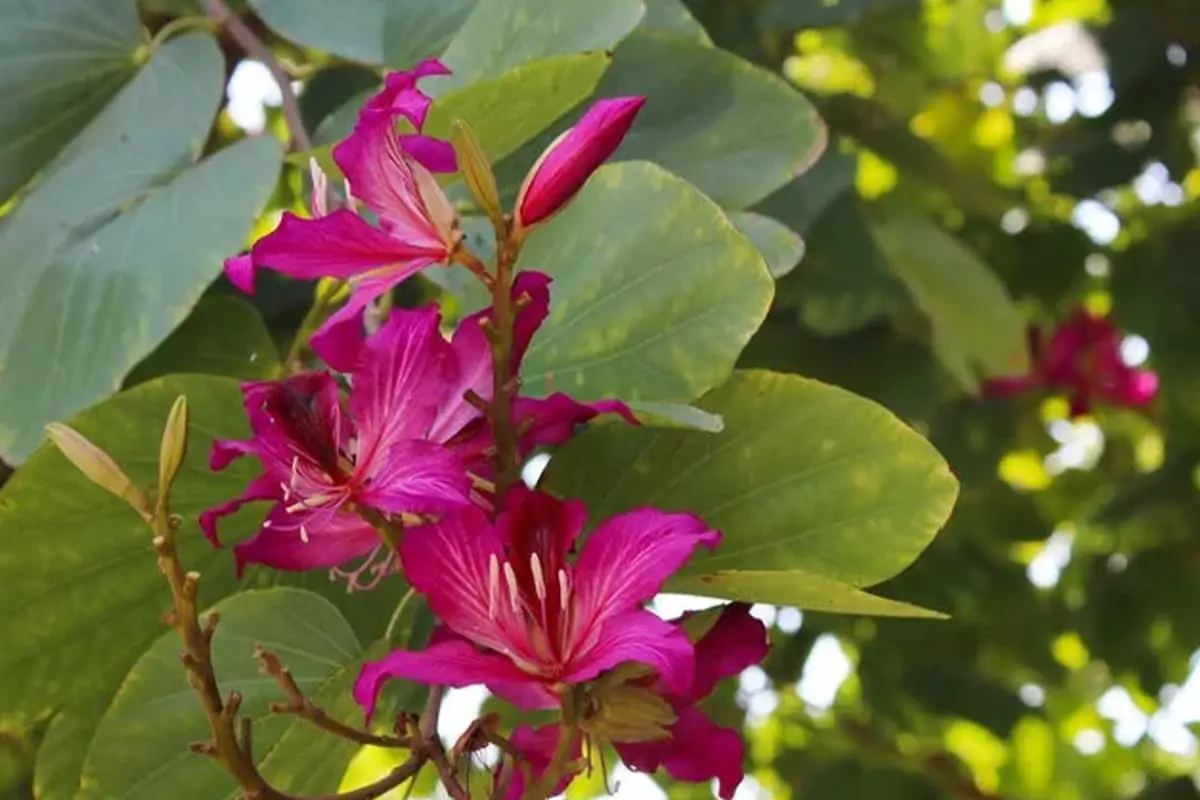
Delonix regia, commonly known as the royal poinciana, flame tree, or flamboyant, is a deciduous tree species belonging to the legume family (Fabaceae). It typically grows 9-12 meters tall and is highly prized for its striking ornamental beauty.
The tree’s main blooming period occurs from late spring to early summer, usually May through July, depending on the climate. It bears large, showy flowers in vibrant shades of scarlet, orange-red, or occasionally yellow. Each flower measures 8-12 cm across and consists of five spreading petals, four of which are similar in size, while the fifth, known as the standard petal, is slightly larger and distinctively marked with yellow and white.
When in full bloom, the tree creates a breathtaking canopy of color, often described as a “floral flame.” The flowers appear in terminal corymbs, forming dense clusters that can nearly obscure the feathery, bipinnate leaves. This spectacular display has earned it the moniker “flame of the forest” in many tropical regions.
Delonix regia is remarkably adaptable to various urban conditions, demonstrating good tolerance to air pollution, making it an excellent choice for street plantings and urban landscapes. However, it’s important to note that the tree is not particularly resistant to smoke or dust; rather, it’s their resilience to urban stressors that makes them suitable for city environments.
Contrary to the original statement, Delonix regia does not emit a fragrance reminiscent of orchids. The flowers are not notably scented, and the tree is not commonly referred to as an “orchid tree.” This nickname is more often associated with trees in the genus Bauhinia, which have orchid-like flowers.
The royal poinciana’s stunning visual display, coupled with its wide-spreading canopy that provides ample shade, makes it a favorite in tropical and subtropical landscapes worldwide. Its beauty extends beyond the flowering season, with long, dark brown seed pods developing after the blooms fade, adding interest to the tree’s silhouette.